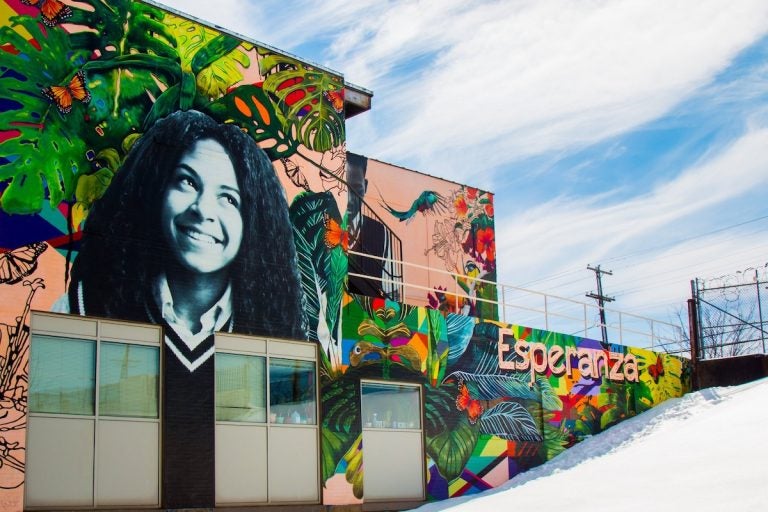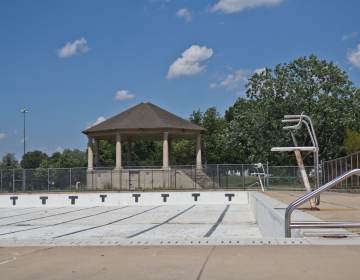Inside Esperanza’s ‘asset-building’ development strategy in Hunting Park
The $18 million project is a marker of the organization’s long-term asset-building strategy for Hunting Park, said Rev. Luis Cortés, Esperanza’s founder, president and CEO.

Esperanza Academy Charter School's mural, “Sembrando Sueños, Cosechando Esperanza” (“Planting Dreams, Harvesting Hope”)(Photo via facebook.com/Esperanzausa)
Years before David Ortiz would serve Hunting Park as the VP of housing and economic development for Esperanza, he grew up in the neighborhood. And he attended the Roberto Clemente Middle School.
Esperanza, the local nonprofit serving the North Philadelphia neighborhood’s Hispanic community, renovated and officially reopened the former school’s building in November after it sat vacant for more than a decade. Now dubbed the Roberto Clemente Homes, it contains 38 affordable housing units and 5,000 square feet of commercial space.
The $18 million project is a marker of the organization’s long-term asset-building strategy for Hunting Park, said Rev. Luis Cortés, Esperanza’s founder, president and CEO.
Cortés’ definition of an asset? “Anything that’s community-controlled.”
“In the United States, you don’t inherit anything,” said Cortés, who manages 450 staffers. “You have to build something. When you build it, it becomes part of the mainstream and then you’re equal with everybody else. As Hispanic people, we need to build things. We need to build institutions that we control.”
Esperanza’s plan
Esperanza’s strategy in Hunting Park is largely guided by a 10-year plan for neighborhood revitalization that targets 80 square blocks and 13,700 residents. The main goals of the plan, which will culminate in 2022, include promoting economic development and community pride.
Hunting Park has higher poverty, unemployment and dropout rates than the statewide average — all issues Esperanza aims to mitigate. But to learn exactly what residents were concerned about when developing the plan, Esperanza employed community engagement by:
- Knocking on doors and surveying 450 people
- Developing a 22-member advisory committee of residents that commented on the information gathered by surveys and progress of the plan
- Held public meetings and focus groups with community stakeholders
Meaningful work in the community requires homework, Cortés said, even for an organization that has worked in Hunting Park for 33 years. It also checks itself along the way with annual internal reviews and some outside perspective. In 2017, for instance, the organization hired the firm Econsult Solutions to assess its impact over the last few decades.
To create change, though, an organization must spend a good amount of it. Since the 1990s, Esperanza has spent nearly $100 million to develop facilities on its 17-acre campus on 5th Street near Hunting Park Avenue. Most recently, the organization has been fundraising $28 million for a performing arts theater, art gallery, conference space and a library for Esperanza College, a higher education institution for Hunting Park residents.
These projects all align with the 10-year plan’s goals and answer the needs residents voiced during the community engagement process, Cortés said. And it all comes down to ownership: Esperanza is firmly rooted in Hunting Park.
“It’s our hope that [Hunting Park] will be forever part of the Latino community, and that’s why we want to … continually create a Hispanic diversity,” the founder said — “a diversity of Hispanic groups, Hispanic entities, but focused on one geographic area so that we can welcome Hispanics to our city into a place where folks can find their language, their culture.”
Putting it into action
For Ortiz in Esperanza’s Housing and Economic Development department, every walk he takes along Hunting Park’s commercial corridors is a chance for community engagement. He often finds himself stopped by neighborhood business owners to talk about their obstacles and Esperanza’s resources.
“We connect the business owners to these resources that they may not know exist and because our staff is bilingual, we can make that connection a lot easier for them,” he said.
Ortiz said his department is largely focused on asset-building outside of the boundaries of Esperanza’s campus. His team manages solutions like street cleanup, storefront improvement, tree planting (for which Education and Community Development Coordinator Gabriella Gabriel Páez won SustainPHL’s 2018 Activist of the Year award) and Esperanza’s Housing Counseling Program.
He’ll also keep an eye on vacant buildings or lots to possibly develop, like Esperanza’s current project at 4615-21 N. 5th Street. The org plans to transform the former church into a multi-use building with affordable housing units and commercial space.
Renovating these spaces is a preventative step against developers building housing that’s not affordable for long-term residents, a root of gentrification, Ortiz said. It keeps the community in control of its own blocks.
According to the 2017 report by Econsult Solutions about Esperanza’s impact, the organization has spent more than $126 million on construction in Hunting Park since 1986, leading to 1,200 jobs with $68 million in earnings. In December, Ortiz’s department also received a $450,000 renewal grant from Wells Fargo to support Esperanza’s resident-driven development and the completion of the 10-year plan.
Ortiz said upkeeping the neighborhood’s physical appearance means more people want to live, work and spend money on businesses there, so Esperanza not only helps create community control, but helps protect what residents have already established.
Cortés said clean streets, freshly painted businesses and shady trees tell residents that their neighborhood is worth time and effort — a message he didn’t get as a child in a low-income New York community.

“The subliminal message is your place would not look like this if you had value, which is why we clean and paint like there’s no tomorrow and we continue to and we will always continue to because it’s not expected,” he said.
Monica Parrilla, co-owner of Marz Auto Central and president of the Hunting Park Business Association, agrees that the neighborhood’s appearance impacts residents’ mentality — and is a marker of its culture. Storefronts along Hunting Park’s commercial corridors are painted bright colors, like red, blue and orange, the colors adorning the front of Parrilla’s shop.
It reminds Parrilla of Puerto Rico, which she left in the 1990s for Philadelphia. It’s also an emblem of the comprehensive work Esperanza does that “keeps our community whole,” Parrilla said.
“It keeps the appearance of the community together,” she said. “I feel like Esperanza is very [focused] on changing the way we look, which makes us more appealing, which brings more business, which brings us money, keeps the economy moving and growing.”
In addition to what Esperanza is doing for the neighborhood’s physical appearance and business owners, its staff says it’s invested in the personal well-being of all local individuals: The organization offers programs ranging from education to the arts to immigration legal counsel.
Cortés’ baseline message is that Hunting Park is worth investments that spur transformation.
“No matter what we do or who you are in the Esperanza family, this is what you do,” Cortés said. “You create a transformative experience, [and] a transformative experience says, ‘I can graduate, I can be employed, I can buy a home.’ [Typically] in a community that’s economically disadvantaged, the understanding is ‘I can’t.’”
 Generocity is one of 22 news organizations producing Broke in Philly, a collaborative reporting project on solutions to poverty and the city’s push toward economic justice.
Generocity is one of 22 news organizations producing Broke in Philly, a collaborative reporting project on solutions to poverty and the city’s push toward economic justice.
WHYY is your source for fact-based, in-depth journalism and information. As a nonprofit organization, we rely on financial support from readers like you. Please give today.




